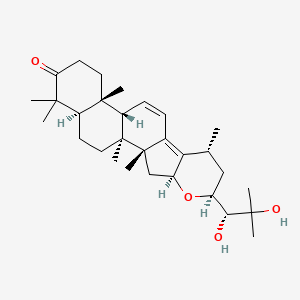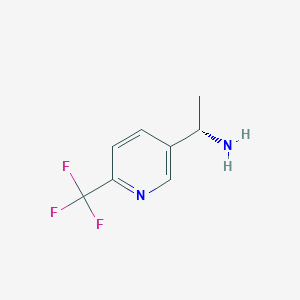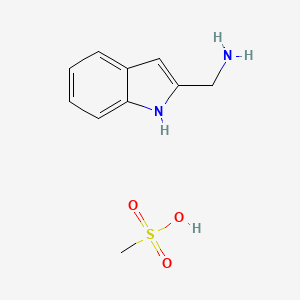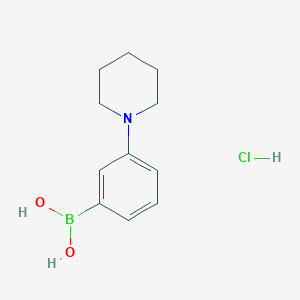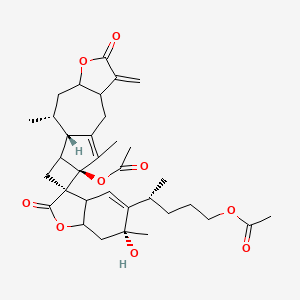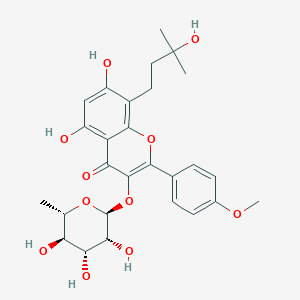![molecular formula C19H20FNO3 B3026791 (3R,4S)-3-[(2H-1,3-BENZODIOXOL-5-YLOXY)METHYL]-4-(4-FLUOROPHENYL)PIPERIDINE CAS No. 112058-85-2](/img/structure/B3026791.png)
(3R,4S)-3-[(2H-1,3-BENZODIOXOL-5-YLOXY)METHYL]-4-(4-FLUOROPHENYL)PIPERIDINE
Overview
Description
Preparation Methods
Synthetic Routes and Reaction Conditions
The synthesis of BRL29060A hemihydrate involves multiple steps, starting from the basic chemical structure of paroxetine. The process includes the formation of the hydrochloride salt and subsequent crystallization to obtain the hemihydrate form. Specific reaction conditions, such as temperature, pH, and solvent choice, are crucial to ensure the purity and yield of the final product .
Industrial Production Methods
Industrial production of BRL29060A hemihydrate follows similar synthetic routes but on a larger scale. The process is optimized for efficiency and cost-effectiveness, often involving automated systems and stringent quality control measures to maintain consistency and purity .
Chemical Reactions Analysis
Types of Reactions
BRL29060A hemihydrate undergoes various chemical reactions, including:
Oxidation: Involves the addition of oxygen or the removal of hydrogen.
Reduction: Involves the addition of hydrogen or the removal of oxygen.
Substitution: Involves the replacement of one atom or group of atoms with another
Common Reagents and Conditions
Common reagents used in these reactions include oxidizing agents like potassium permanganate, reducing agents like lithium aluminum hydride, and various nucleophiles for substitution reactions. Reaction conditions such as temperature, solvent, and catalysts play a significant role in determining the reaction pathway and yield .
Major Products
The major products formed from these reactions depend on the specific reagents and conditions used. For example, oxidation may yield hydroxylated derivatives, while reduction may produce deoxygenated compounds .
Scientific Research Applications
BRL29060A hemihydrate has a wide range of scientific research applications:
Chemistry: Used as a reference compound in analytical studies and method development.
Biology: Studied for its effects on neurotransmitter systems and cellular signaling pathways.
Industry: Utilized in the development of new pharmaceutical formulations and drug delivery systems
Mechanism of Action
BRL29060A hemihydrate exerts its effects by inhibiting the reuptake of serotonin, a neurotransmitter, at the presynaptic neuron. This inhibition increases the concentration of serotonin in the synaptic cleft, enhancing serotonergic neurotransmission. The compound also inhibits G protein-coupled receptor kinase 2 (GRK2) activity, contributing to its therapeutic effects .
Comparison with Similar Compounds
BRL29060A hemihydrate is compared with other selective serotonin-reuptake inhibitors such as:
While all these compounds share a similar mechanism of action, BRL29060A hemihydrate is unique in its specific inhibitory effects on GRK2, which may contribute to its distinct therapeutic profile .
Properties
IUPAC Name |
(3R,4S)-3-(1,3-benzodioxol-5-yloxymethyl)-4-(4-fluorophenyl)piperidine | |
|---|---|---|
| Details | Computed by Lexichem TK 2.7.0 (PubChem release 2021.05.07) | |
| Source | PubChem | |
| URL | https://pubchem.ncbi.nlm.nih.gov | |
| Description | Data deposited in or computed by PubChem | |
InChI |
InChI=1S/C19H20FNO3/c20-15-3-1-13(2-4-15)17-7-8-21-10-14(17)11-22-16-5-6-18-19(9-16)24-12-23-18/h1-6,9,14,17,21H,7-8,10-12H2/t14-,17-/m1/s1 | |
| Details | Computed by InChI 1.0.6 (PubChem release 2021.05.07) | |
| Source | PubChem | |
| URL | https://pubchem.ncbi.nlm.nih.gov | |
| Description | Data deposited in or computed by PubChem | |
InChI Key |
AHOUBRCZNHFOSL-RHSMWYFYSA-N | |
| Details | Computed by InChI 1.0.6 (PubChem release 2021.05.07) | |
| Source | PubChem | |
| URL | https://pubchem.ncbi.nlm.nih.gov | |
| Description | Data deposited in or computed by PubChem | |
Canonical SMILES |
C1CNCC(C1C2=CC=C(C=C2)F)COC3=CC4=C(C=C3)OCO4 | |
| Details | Computed by OEChem 2.3.0 (PubChem release 2021.05.07) | |
| Source | PubChem | |
| URL | https://pubchem.ncbi.nlm.nih.gov | |
| Description | Data deposited in or computed by PubChem | |
Isomeric SMILES |
C1CNC[C@@H]([C@H]1C2=CC=C(C=C2)F)COC3=CC4=C(C=C3)OCO4 | |
| Details | Computed by OEChem 2.3.0 (PubChem release 2021.05.07) | |
| Source | PubChem | |
| URL | https://pubchem.ncbi.nlm.nih.gov | |
| Description | Data deposited in or computed by PubChem | |
Molecular Formula |
C19H20FNO3 | |
| Details | Computed by PubChem 2.1 (PubChem release 2021.05.07) | |
| Source | PubChem | |
| URL | https://pubchem.ncbi.nlm.nih.gov | |
| Description | Data deposited in or computed by PubChem | |
DSSTOX Substance ID |
DTXSID90860771 | |
| Record name | (+)-Paroxetine | |
| Source | EPA DSSTox | |
| URL | https://comptox.epa.gov/dashboard/DTXSID90860771 | |
| Description | DSSTox provides a high quality public chemistry resource for supporting improved predictive toxicology. | |
Molecular Weight |
329.4 g/mol | |
| Details | Computed by PubChem 2.1 (PubChem release 2021.05.07) | |
| Source | PubChem | |
| URL | https://pubchem.ncbi.nlm.nih.gov | |
| Description | Data deposited in or computed by PubChem | |
CAS No. |
112058-85-2 | |
| Record name | Paroxetine, (+)- | |
| Source | ChemIDplus | |
| URL | https://pubchem.ncbi.nlm.nih.gov/substance/?source=chemidplus&sourceid=0112058852 | |
| Description | ChemIDplus is a free, web search system that provides access to the structure and nomenclature authority files used for the identification of chemical substances cited in National Library of Medicine (NLM) databases, including the TOXNET system. | |
| Record name | (+)-Paroxetine | |
| Source | EPA DSSTox | |
| URL | https://comptox.epa.gov/dashboard/DTXSID90860771 | |
| Description | DSSTox provides a high quality public chemistry resource for supporting improved predictive toxicology. | |
| Record name | PAROXETINE, (+)- | |
| Source | FDA Global Substance Registration System (GSRS) | |
| URL | https://gsrs.ncats.nih.gov/ginas/app/beta/substances/58SBH37T77 | |
| Description | The FDA Global Substance Registration System (GSRS) enables the efficient and accurate exchange of information on what substances are in regulated products. Instead of relying on names, which vary across regulatory domains, countries, and regions, the GSRS knowledge base makes it possible for substances to be defined by standardized, scientific descriptions. | |
| Explanation | Unless otherwise noted, the contents of the FDA website (www.fda.gov), both text and graphics, are not copyrighted. They are in the public domain and may be republished, reprinted and otherwise used freely by anyone without the need to obtain permission from FDA. Credit to the U.S. Food and Drug Administration as the source is appreciated but not required. | |
Synthesis routes and methods I
Procedure details










Synthesis routes and methods II
Procedure details








Synthesis routes and methods III
Procedure details





Retrosynthesis Analysis
AI-Powered Synthesis Planning: Our tool employs the Template_relevance Pistachio, Template_relevance Bkms_metabolic, Template_relevance Pistachio_ringbreaker, Template_relevance Reaxys, Template_relevance Reaxys_biocatalysis model, leveraging a vast database of chemical reactions to predict feasible synthetic routes.
One-Step Synthesis Focus: Specifically designed for one-step synthesis, it provides concise and direct routes for your target compounds, streamlining the synthesis process.
Accurate Predictions: Utilizing the extensive PISTACHIO, BKMS_METABOLIC, PISTACHIO_RINGBREAKER, REAXYS, REAXYS_BIOCATALYSIS database, our tool offers high-accuracy predictions, reflecting the latest in chemical research and data.
Strategy Settings
| Precursor scoring | Relevance Heuristic |
|---|---|
| Min. plausibility | 0.01 |
| Model | Template_relevance |
| Template Set | Pistachio/Bkms_metabolic/Pistachio_ringbreaker/Reaxys/Reaxys_biocatalysis |
| Top-N result to add to graph | 6 |
Feasible Synthetic Routes
Disclaimer and Information on In-Vitro Research Products
Please be aware that all articles and product information presented on BenchChem are intended solely for informational purposes. The products available for purchase on BenchChem are specifically designed for in-vitro studies, which are conducted outside of living organisms. In-vitro studies, derived from the Latin term "in glass," involve experiments performed in controlled laboratory settings using cells or tissues. It is important to note that these products are not categorized as medicines or drugs, and they have not received approval from the FDA for the prevention, treatment, or cure of any medical condition, ailment, or disease. We must emphasize that any form of bodily introduction of these products into humans or animals is strictly prohibited by law. It is essential to adhere to these guidelines to ensure compliance with legal and ethical standards in research and experimentation.



